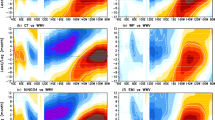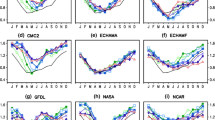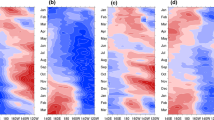Abstract
A hierarchy of ENSO (El Niño/Southern Oscillation) prediction schemes has been developed which includes statistical schemes and physical models. The statistical models are, in general, based on advanced statistical techniques and can be classified into models which use either low-frequency variations in the atmosphere (sea level pressure or surface wind) or upper ocean heat content as predictors. The physical models consist of coupled ocean-atmosphere models of varying degrees of complexity, ranging from simplified coupled models of the ‘shallow water’-type to coupled general circulation models. All models, statistical and physical, perform considerably better than the persistence forecast on predicting typical indices of ENSO on lead times of 6 to 12 months. The most successful prediction schemes, the fully physical coupled ocean-atmosphere models, show significant prediction abilities at lead times exceeding one year period. We therefore conclude that ENSO is predictable at least one year in advance. However, all of this applies to gross indices of ENSO such as the Southern Oscillation Index. Despite the demonstrated predictability, little is known about the predictability of specific features known to be associated with ENSO (e.g. Indian Monsoon rainfall, Southern African drought, or even off-equatorial sea surface temperature). Nor has the relative importance for prediction of different regional anomalies or different physical processes yet been established. A seasonal dependence in predictability is well established, but the processes responsible for it are not fully understood.
Similar content being viewed by others
References
Barber RT, Chavez FP (1983) Biological consequences of El Niño. Science 222:1203–1210
Barnett TP (1983) Interaction of the Monsoon and Pacific Trade Wind system at interannual time scales. Part I: the equatorial zone. Mon Weather Rev 111:756–773
Barnett TP (1985) Variations in near-global sea level pressure. J Atmos Sci 42:478–501
Barnett TP (1991) The interaction of multiple time scales in the tropical climate system. J Clint 4:269–285
Barnett TP, Hasselmann K (1979) Techniques of linear prediction, with application to oceanic and atmospheric fields in the tropical Pacific. Rev Geophys Space Phys 17:949–968
Barnett TP, Preisendorfer R (1987) Origins and levels of monthly forecast skill for United States surface air temperatures determined by canonical correlation analysis. Mon Weather Rev 115:1825–1850
Barnett TP, Graham NE, Cane NA, Zebiak SE, Dolan SC, O'Brien JJ, Legeler DM (1988) On the prediction of the El Niño of 1986–1987. Science 241:192–196
Barnett TP, Dümenil L, Schlese U, Roeckner E, Latif M (1989) The effect of Eurasian snow cover on regional and global climate variations. J Atmos Sci 46:661–685
Barnett TP, Latif M, Kirk E, Roeckner E (1991) On ENSO physics. J Clim 4:487–515
Barnett TP, Latif M, Graham NE, Flugel M, Pazan SE, White WB (1993) ENSO and related variability. Part I: prediction of equatorial Pacific sea surface temperature with a hybrid coupled ocean-atmosphere model. J Clim (in press)
Barnston AG, Ropeleski CF (1993) Prediction of ENSO episodes using canonical correlation analysis. J Clim 5:1316–1345
Battisti DS (1988) Dynamics and thermodynamics of a warming event in a coupled tropical atmosphere-ocean model. J Atmos Sci 45:2889–2919
Battisti DS, Hirst AC (1989) Inerannual variability in a tropical atmosphere-ocean model: Influence of the basic state, ocean geometry and nonlinearity. J Atmos Sci 46:1687–1712
Blumenthal MB (1991) Predictability of a coupled ocean-atmosphere model. J Clim 4:766–784
Busalacchi AJ, Takeuchi K, O'Brien JJ (1983) Interannual variability of the equatorial Pacific. Hydrodynamics of the Equatorial Ocean. Nihoul JCJ (ed), Elsevier Oceanogr Ser vol 36
Cane MA (1983) Oceanographic events during El Niño. Science 222:1189–1195
Cane MA (1991) Forecasting El Niño with a geophysical model. In: Glantz M, Katz RW, Nicholls N (eds) Teleconnections linking worldwide climate anomalies. Cambridge University Press
Cane MA, Sarachik ES (1981) The response of a linear baroclinic equatorial ocean to periodic forcing. J Mar Res 39:651–693
Cane MA, Zebiak SE, Dolan SC (1986) Experimental forecasts of El Niño. Nature 321:827–832
Cane MA, Münnich M, Zebiak SE (1990) A study of self-excited oscillations of the tropical ocean-atmosphere system. Part I: linear analysis. J Atmos Sci 47:1562–1577
Chao Y, Philander SGH (1991) On the structure of the Southern Oscillation and evaluation of coupled ocean-atmosphere models. TOGA Notes 3:1–8
Davis RE (1977) Techniques of statistical analysis and prediction of geophysical fluid systems. Geophys Astrophys Fluid Dyn 8:245–277
Firring E, Lukas R, Sadler J, Wyrtki K (1983) Equatorial undercurrent disappears during 1982–1983 El Niño. Science 222:1121–1123
Gill AE, Rasmusson EM (1983) The 1982–83 climate anomaly in the equatorial Pacific. Nature 306:229–234
Glantz MH, Katz RW, Nicholls N (eds) (1991) Teleconnections linking worldwide climate anomalies. Cambridge University Press, Cambrige, UK
Goswami BN, Shukla J (1991) Predictability of a coupled ocean-atmosphere model. J Clim 4:-22
Graham NE, White WB (1988) The El Niño cycle: a natural oscillator of the Pacific Ocean-atmosphere system. Science 240:1293–1302
Graham NE, Michaelsen J, Barnett TP (1987a) An investigation of the El Niño-Southern Oscillation cycle with statistical models. 1. Predictor field characteristics. J Geophys Res 92, C13:14251–14270
Graham NE, Michaelsen J, Barnett TP (1987b) An investigation of the El Niño-Southern Oscillation cycle with statistical models. 2. Model results. J Geophys Res 92, C13:14271–14289
Graham NE, Barnett TP, Latif M (1992) Considerations of the predictability of ENSO with a low-order coupled model. TOGA Notes 7:11–15
Hahn DJ, Shukla J (1976) An apparent relationship between Eurasian snow cover and Indian monsoon rainfall. J Atmos Sci 33:2461–2462
Hayes SP, Magnum LJ, Picaut J, Sumi A, Takeuchi K (1991) TOGA-TAO: a moored array for real-time measurements in the tropical Pacific Ocean. Bull Am Meteorol Soc 72:339–347
Hasselmann K (1988) PIPs and POPS: the reduction of complex dynamical systems using principal interaction and oscillation patterns. J Geophys Res 93, 139:11015–11021
Hasselmann K, Barnett TP (1981) Techniques of linear prediction for systems for periodic statistics. J Atmos Sci 38:2275–2283
Hotelling H (1935) Relations between two sets of variates. Biometrica 28:321–377
Inoue M, O'Brien JJ (1984) A forecasting model for the onset of El Niño. Mon Weather Rev: 112, 2326–2337
Latif M, Flugel M (1991) An investigation of short range climate predictability in the tropical Pacific. J Geophys Res 96, C2:2661–2673
Latif M, Graham NE (1992) How much predictive skill is contained in the thermal structure of an OGCM? J Phys Oceanogr 22:951–962
Latif M, Sterl A, Maier-Reimer E, Junge MM (1993a) Climate variability in a coupled GCM. Part I: the tropical Pacific. J Clim (in press)
Latif M, Sterl A, Maier-Reimer E, Junge MM (1993b) Structure and predictability of the El Niño/Southern Oscillation phenomenon in a coupled ocean-atmosphere general circulation model. J Clim (in press)
Lau NC, Philander SGH, Nath MJ (1992) Simulation of ENSOlike phenomena with a low-resolution coupled GCM of the global ocean and amtosphere. J Clim 5:284–307
Madden RA, Julian PR (1972) Description of global-scale circulation cells in the tropics with a 40–50 day period. J Atmos Sci 24:1109–1123
McCreary JP (1983) A model of tropical ocean-atmosphere interaction. Mon Weather Rev 111:370–387
Meehl GA (1987) The annual cycle and interannual variability in the tropical Pacific and Indian Ocean regions. Mon Weather Rev 115:27–50
Meehl GA (1990) Seasonal cycle forcing of El Niño-Southern Oscillation in a global coupled ocean-atmosphere GCM. J Clim 2:72–98
Miyakoda K, Rosati A, Gudgel R (1992) Toward the GCM seasonal forecasts. CAS Group of Rapporteurs on Medium- and Long-range Weather Prediction Research. Toulouse, 10–14 February, 1992
Münnich M, Cane MA, Zebiak SE (1991) A study of self-excited oscillations of the tropical ocean-atmosphere system. Part II: nonlinear cases. J Atmos Sci 48:1238–1248
Neelin JD, Latif M, Allaart MAF, Cane MA, Cubasch U, Gates WL, Gent PR, Ghil M, Gordon C, Lau NC, Mechoso CR, Meehl GA, Oberhuber JM, Philander SGH, Schopf PS, Sperber KR, Sterl A, Tokioka T, Tribbia J, Zebiak SE (1992) Tropical air-sea interaction in general circulation models. Clim Dyn 7:73–104
Oceanus (1984) El Niño. Vol 27, no. 2, summer
Philander SGH, Pacanowski RC, Lau NC, Nath MJ (1991) A simulation of the Southern Oscillation with a global atmospheric GCM coupled to a high-resolution, tropical Pacific ocean GCM. J Clim 5:308–329
Rasmusson EM, Carpenter TH (1982) Variations in tropical sea surface temperature and surface wind fields associated with the Southern Oscillation/El Niño. Mon Weather Rev 10:354–384
Rasmusson EM, Wallace JM (1983) Meteorological aspects of the El Niño/Southern Oscillation. Science 222:1195–1202
Rasmusson EM, Wang X, Ropelewski CF (1990) The biennial component of ENSO variability. J Mar Sys 1:71–96
Ropelewski CF, Halpert MS (1989) Precipitation patterns associated with the high index phase of the Southern Oscillation. J Clim 2:268–284
Ropelewski CF, Halpert MS, Wang X (1992) Observed tropospheric biennial variability and its realtionship to the Southern Oscillation. J Clim 5:594–614
Sausen R, Barthel K, Hasselmann K (1988) Coupled ocean-atmosphere models with flux correction. Clim Dyn 2:145–163
Schopf PS, Suarez MJ (1988) Vacillations in a coupled ocean-atmosphere model. J Atmos Sci 45:549–566
Storch H, van Loon H, Kiladis GH (1988a) The Southern Oscillations. Part VIII: sensitivity to SST anomalies in the tropical and subtropical regions of the South Pacific Convergence Zone. J Clim 1:325–331
Storch H, Bruns T, Fischer-Bruns I, Hasselmann K (1988b) Principal oscillation analysis of the 30 to 60 day oscillation in a GCM. J Geophys Res 93, D9:11022–11036
Syu H, Neelin JD, Weibel W, Gutzler D (1992) Tropical ocean-atmosphere interaction in a hybrid coupled GCM: seasonal cycle and interannual oscillations. Abstract Volume, Fourth Symposium on Global Change Studies, Jan. 18–21, Anaheim, Calif, American Meteorological Society, Boston
Tai CK, White WB, Pazan SE (1989) Geosat crossover analysis in the tropical Pacific. 2. Verification analysis of altimetric sea level maps with expendable bathythermograph and island sea level data. J Geophys Res 94, C1:897–908
van Loon H (1984) The Southern Oscillation. Part III: associations with the trades and with the through in the westerlies of the South Pacific Ocean. Mon Weather Rev 112:947–954
van Loon H, Shea DJ (1985) The Southern Oscillation. Part IV: the precursors south of 15°S to the extremes of the oscillation. Mon Weather Rev 113:2063–2074
Weese U (1991) Principal Interaction/Oscillation Patterns. Theorie and Analysen zum El Niño/Southern Oscillation-Phäno-men. PhD Thesis, Max-Planck-Institut fur Meteorologie, Hamburg, FRG
WMO (1992) Report on the Fifth Session of the TOGA Numerical Experimentation Group, San Francisco, Dec. 1991, WMO/ TD-No 487. World Meteorological Organization, Geneva, Switzerland
White WB, Pazan SE, Inoue M (1987) Hindcast/forecast of ENSO events based upon the redistribution of observed and model heat content in the western tropical Pacific, 1964–86. J Phys Oceanogr 17:264–280
Wright PB (1985) The Southern Oscillation. An ocean-atmosphere feedback system? Bull Am Meteorol Soc 66:398–412
Wyrtki K (1975) El Niño — The dynamic response of the equatorial Pacific Ocean to atmospheric forcing. J Phys Oceanogr 5:572–584
Wyrtki K (1985) Water displacements in the Pacific and the genesis of El Niño cycles. J Geophys Res 90, C4:7129–7132
Xu JS, Storch H (1990) Principal oscillations patterns — prediction of the state of ENSO. J Clim 3:1316–1329
Zebiak SE, Cane MA (1987) A model El Niño — Southern Oscillation. Mon Weather Rev 115:2262–2278
Author information
Authors and Affiliations
Rights and permissions
About this article
Cite this article
Latif, M., Barnett, T.P., Cane, M.A. et al. A review of ENSO prediction studies. Climate Dynamics 9, 167–179 (1994). https://doi.org/10.1007/BF00208250
Received:
Accepted:
Issue Date:
DOI: https://doi.org/10.1007/BF00208250




